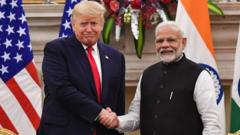
Trade Tensions Simmer as Tariff Pause Deadline Looms
With the pivotal date of July 9th rapidly approaching, the expiration of the current tariff pause hangs heavy in the air, casting a shadow of uncertainty over international trade relations. While optimism for a continued truce persists within certain sectors, the negotiating table remains a battleground, with both sides entrenched in complex and, at times, seemingly intractable positions.
High Stakes, Higher Expectations
The implications of failing to secure an extension to the tariff pause are far-reaching, potentially impacting global supply chains, consumer prices, and investor confidence. Businesses across a multitude of industries are bracing themselves for the potential consequences, meticulously analyzing risk mitigation strategies and contingency plans. The stakes are demonstrably high, and the pressure on negotiators to find common ground is immense.
Negotiating Challenges: A Deep Dive
Sources close to the ongoing discussions indicate that several key sticking points continue to impede progress. These include:
- Intellectual Property Protection: Disagreements persist regarding the enforcement of intellectual property rights and the prevention of technology theft.
- Market Access: Concerns remain about equitable market access for goods and services, particularly in strategic sectors.
- Trade Imbalances: Addressing the persistent trade imbalances between the negotiating parties remains a contentious issue, with competing proposals on how to achieve a more balanced trading relationship.
- Enforcement Mechanisms: The establishment of robust and verifiable enforcement mechanisms to ensure compliance with any agreed-upon terms is proving to be a significant hurdle.
A Glimmer of Hope? Potential Paths Forward
Despite the formidable challenges, glimmers of hope remain. Several potential pathways to a successful extension of the tariff pause have been identified, including:
- Phase-by-Phase Approach: Implementing a phased reduction in tariffs linked to the fulfillment of specific commitments could provide a framework for continued progress.
- Sector-Specific Agreements: Focusing on sector-specific agreements could allow for targeted solutions to address particular areas of concern.
- Enhanced Dialogue and Transparency: Fostering greater transparency and open communication channels could build trust and facilitate constructive dialogue.
- Mediation Efforts: Engaging neutral third-party mediators could help to bridge the gaps between the negotiating positions.
Economic Impact Assessment: The Ripple Effect
Economists are actively assessing the potential economic impact of various scenarios, ranging from a complete breakdown in negotiations to a comprehensive and lasting trade agreement. A return to heightened tariffs could trigger a cascade of negative consequences, including:
- Increased inflationary pressures, eroding consumer purchasing power.
- Disruptions to global supply chains, leading to production bottlenecks and delays.
- Reduced investment and economic growth, dampening overall economic activity.
- Heightened geopolitical tensions, further destabilizing the international landscape.
Business Sentiment: A Cautious Outlook
Business sentiment remains cautiously optimistic, with many companies expressing a desire for a resolution that provides stability and predictability. However, concerns are mounting as the deadline draws nearer, and businesses are increasingly preparing for a potential worst-case scenario. Survey data reveals a growing trend of companies diversifying their supply chains and exploring alternative markets to mitigate the risks associated with trade uncertainty.
The Road Ahead: Key Considerations
In the days leading up to July 9th, the focus will be on intensifying negotiations and seeking compromise solutions. Key considerations will include:
- The willingness of both sides to make concessions and bridge their differences.
- The ability to establish credible enforcement mechanisms to ensure compliance.
- The commitment to fostering a long-term, mutually beneficial trading relationship.
The world watches with bated breath as the clock ticks down, hoping for a positive outcome that averts a potentially damaging trade war. The future of global trade hangs in the balance.
```